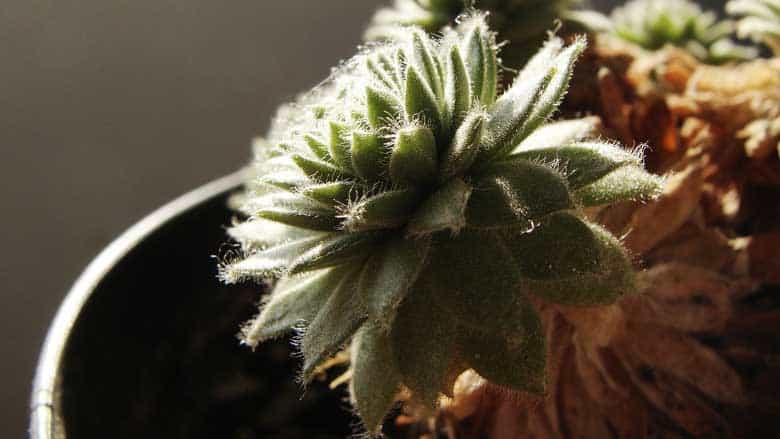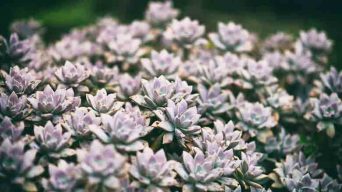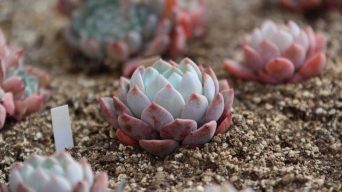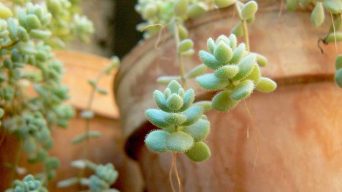How much light do succulents need to grow and thrive? This is a common question for those looking to care for their succulent plants.
While many believe succulents and cacti thrive solely on direct sunlight, this is not accurate.
Succulents, much like other houseplants, require indirect light, which can come from windows or various other sources, to flourish.
Therefore, it’s vital to ensure your houseplants are positioned in an area that receives sufficient indirect light, promoting their health and growth.
In this article, we will discuss the optimal light conditions for succulents, empowering you to cultivate them successfully within your home!
Sunlight Requirements for Succulents
Succulents require six hours of indirect light daily to thrive, like full to partial shade exposure.
However, too much exposure to the sun can cause your succulents to burn, so make sure they don’t get too hot. Succulent leaves will turn a pale white if their plant is getting too much light.
Succulents can survive in a variety of lighting conditions. Still, they grow best with six hours of indirect sunlight every day.
If you place your succulent in an area that doesn’t receive any sun, consider moving it into a spot with more light or supplementing the light from its current location.
Succulents need time to adjust to a change in lighting conditions, so make sure you gradually place them in the new area over several days. This allows your plant enough time to get used to its new surroundings slowly, making it less likely to suffer stress.
If you live in an area that does not get six hours of sunlight, it is okay if the succulents receive indirect light for four to five hours. If your plants aren’t getting enough natural light during the day, you can supplement with artificial lighting to make up the difference.
Succulents are resilient and will survive even when they don’t receive as much sun as they need. However, bright sunlight can bring out the vivid colors of the succulents, making them even more beautiful and eye-catching.
However, this may affect how quickly or slowly they grow over time. It also affects their appearance – yellowing leaves mean a lack of sufficient sun exposure!
Succulents do best when left outside on a covered porch with some shade from trees but still get plenty of ambient outdoor light throughout most days.
A few hours of direct morning or afternoon sun is best for most succulent plants—especially indoors, where they receive less intense rays throughout the day.
The Optimal Light Conditions for Succulents
Succulents need direct and indirect light throughout the day to grow and thrive.
Direct sun is essential for photosynthesis, but too much can burn succulents. Indirect sunlight means that the succulents are not in direct line of sight to a light source, but they receive it and, therefore, can still grow.
Succulent plants need at least four to six hours of direct sunlight daily. If they do not receive enough light, their growth will be stunted, and the leaves may turn yellow or misshapen.
Succulents that receive too much sun exposure can burn the tips of their leaves, which causes them to lose water through evaporation more rapidly than usual due to damaged stomata on the surface of succulent tissue.
Sunburned succulents also become more susceptible to disease and insect attacks.
Succulents getting too much sun may also start growing abnormally, taking on a stretched-out appearance due to the excessive water loss they experience through their leaves.
Indirect sunlight will still allow succulents to photosynthesize but does not provide enough light to grow at their optimal rate.
The plant’s growth may slow down, and leaves will turn pale green or yellow if they do not receive enough light throughout the day.
The best way to avoid over and underexposure of succulents to the sun is to place them near a large window, but not directly in front.
Succulents should receive indirect light throughout the day. If they receive too much direct sunlight, move them further away from the windowsill or plant stand until they start growing normally again.
Is it Safe for Succulents to Be Exposed to Direct Sunlight All Day?
When exposed to direct sunlight for too long, succulent plants can become sunburned, so it’s important to ensure that they get a good balance of direct and indirect sunlight for at least five hours per day to keep them healthy and thriving.
Succulents need light to grow and thrive, but direct sunlight can be too harsh for these plants, especially during summer.
Succulent plants should receive five hours of direct sunlight each day, and for an additional two to four hours, they can be in indirect or filtered light.
Indirect light is often a better option for succulents, as it is softer and less harsh. It provides the succulents with the right amount of light without burning them.
Providing Adequate Light for Indoor Succulents
Succulents need some light to grow and thrive. However, the amount of light they require can vary by type.
Some types of succulents naturally do well in low-light conditions. In contrast, others thrive only when they get lots of direct light daily.
The amount of light each type needs also depends on where the succulent is grown.
Succulents can grow well in low-light conditions if given enough bright indirect light and get five hours or more daily.
The best way to give them this kind of lighting indoors is by placing them near an east- or west-facing window. South-facing windows provide the most light, but east- and west-facing windows can also provide enough light for your plants to thrive.
The amount of light that your plants receive will depend on the size of the window, its orientation, and the amount of direct sunlight it receives.
Succulents placed close to windows will benefit from diffused morning or afternoon sun filtered through sheer curtains or blinds. This helps prevent direct contact between the plants and intense beams of sunlight, which can sunburn their leaves and stems over time.
If you are growing succulents in very low-light conditions, you must ensure they get enough indirect sunlight throughout the day.
Succulents with yellow or blueish leaves will let you know when they need more light. When they start looking pale and “washed out,” that means their bodies are experiencing a form of stress known as etiolation caused by too little sun exposure.
The amount of light needed indoors also depends on the succulent species. For example, cactus plants and other desert types of succulents need even more light to thrive than jungle varieties. However, they can both grow well indoors with enough ambient light.
Understanding Artificial Lighting for Succulents
When growing succulents indoors, you can give them as much or as little artificial light as they need.
The more natural light your succulents receive, the better it will be for their growth and health.
If you are growing succulents indoors with no access to any natural light (or if the amount is very low), use full-spectrum fluorescent light with a color temperature of around 5000 Kelvins.
These lights mimic daylight well, which would be best for your plants’ photosynthesis.
You may also want to find out how far away from the grow lights you need to keep your succulents. Different plants require different amounts of space between them and the grow light source.
Additionally, you can use a grow light timer so that your succulents receive the proper amount of artificial light daily.
You can give indoor succulent plants anywhere from 12 to 14 hours of light exposure daily.
For example, if you use a timer on your grow lights, set them for 13-14 hours daily (or between 12 and 14).
You can use timers to turn the lights off at night so they don’t overheat or malfunction while not needed.
Also, ensure to water your succulents according to their needs throughout this period.
Outdoor Lighting for Healthy Succulents
Growing outdoor succulents is popular as they do not require much upkeep and can grow in full sun.
Outdoors, succulents prefer bright light, but if the spot is too sunny, it may cause the leaves to burn or turn white or develop brown spots.
If growing outdoors, place your plant in an area with about six hours of bright sunlight and some shade during hotter weather.
If you are unsure if your succulent plant is getting enough light, it’s best to err on caution and place it in a spot that receives bright but indirect sunlight.
This will allow for some time in the sun while avoiding any harmful burning or scorching of leaves.
A good location for succulents outdoors is in a partially covered area where they will get bright light for up to six hours and some protection from harsh direct sunlight.
Succulents that receive too little or too much light may wilt and sunburn, so it’s essential to keep them out of direct sunlight during extreme heat conditions.
Winter Light Considerations for Succulents
Succulents need bright light but not direct sunlight in winter.
You can move your succulent pot or hang it under a window that gets plenty of indirect sun for at least five hours per day during the cooler seasons (fall and winter).
The best time to give them this kind of lighting is around mid-morning because, by afternoon, their leaves get too hot from the rays coming through the glass.
If your plant gets too little light, the ends of its leaves will look burnt and dry. If this happens, move it closer to a window or increase its exposure by using full-spectrum fluorescent lights on top of the pot.
You should also rotate the container every time you water it so all sides get equal exposure to light over time.
The amount of indirect sunlight that most types of succulent plants receive in winter is enough for them to survive and thrive during these months when there are fewer hours of daylight each day.
Assessing Succulent Growth in Shaded or Low-Light Environments
Some succulents can grow in low light, but most require direct light.
However, if you want to encourage your plant to thrive and produce flowers and new growth, it will need at least five hours of natural sunlight daily.
Succulents with thick fleshy leaves are more tolerant to shade than succulents with thin leaves.
Some succulent plants, like the Aloe aristata or the Kalanchoe tomentosa, can grow in low light but may require more than four hours of sun per day.
Unfortunately, low-light succulent plants like this are very slow-growing. They may take up to five years before producing their first flower bud!
This is not ideal for most people who want instant results from their indoor garden.
Most succulent varieties prefer direct sun exposure because they evolved in hot desert climates. The intense heat causes them to store more water inside of their leaves than cooler regions with less sunshine would warrant.
It may be enough if you live in an area with four hours of full sunlight, but your house gets exposed to more light for a few hours in the morning or afternoon.
Recognizing Signs of Inadequate Light for Succulents
The best way to tell if a succulent is not getting the right amount of light is to look for signs of stretching (this is known as etiolation).
A plant will stretch when trying to reach for more light. This is a sign that your succulents are too far away from the light source.
Another thing succulents do when they are not getting enough light is to produce smaller leaves.
If you see many small yellow leaves on the plant, it also shows that it needs more light.
If you suspect your succulents are not getting enough light, try moving them to a brighter location and see if they perk up!
On the other hand, if you notice that your succulents are getting too much light, they will start to look scorched or dry. This can be indicated by the edges of leaves turning brown and crispy or the leaves appearing bleached out.
If this happens, try moving your succulents into a shadier location and see if they look better!
Succulents are very resilient plants that can survive in many different conditions. Still, it’s essential to ensure that you provide them with enough sunlight for optimal growth.
Final Thoughts
To ensure your succulents stay healthy, it is important to provide them with proper care, including making sure they get the right amount of light, as well as watering and fertilizing them regularly.
If you are still determining what lighting conditions your succulents prefer, try starting with bright, indirect east, or west exposure for at least five hours daily.
This will give most types of succulents all the sun exposure required when grown outdoors or indoors in sunny rooms.
This type of lighting works best for almost every variety within this plant family, including Sedum, Haworthia, Sempervivum, Aeonium, Echeveria, and many others.







